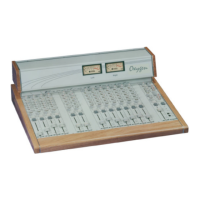Each MULTI module has six switchable and/or summable stereo line inputs with optional
three-band EQ. Input A through F come factory preset for Line levels.
The selected source (or the sum of the selected sources) is fed through a common GAIN
potentiometer that provides a variable 30dB range from -15 to +15dB gain to match the
connected source to the internal 0 dBu operating level.
The Equaliser (available as an option – Ref to Section Errore. L'origine riferimento
non è stata trovata.) comprises three sections. The upper control provides H.F.(treble)
boost and cut of +/-15dB at 13 kHz, and the lower control provides L.F. (bass) boost and
cut of +/-15dB at 100 Hz. The centre knob provides a cut/boost control of +/- 15dB at 5
kHz. Set the cut/boost control of each section to the centre-detented position when not
required.
The signal is then routed via a Balance control and two stereo routing switches to either
the main stereo programme (Master) or the stereo subgroup (Sub).
There is a red LED inside each switch which will illuminate accordingly.
The pre-fade listening. PFL button mode allows pre-fade listening (post pan-pot) of the
channel with the fader closed. When the PFL button is activated, the channel signal will
be connected to the PFL output and to the meters circuitry (see also METERBRIDGE
Chapter). Even when the channel is active, the PFL system is active. It always operates
in the SINGLE Mode (i.e. only one PFL is active at once). The PFL function can be
cancelled:
A 9 pin D-Type plug remote connector provides the remote outputs (optocoupled or not)
for the Start and Stop functions, controlled by START button. The remote Start/Stop
operation can be jumper configured to be either momentary or latched (a feature that
may be required for some types of equipment).
ALPS N-type 90° ultra smooth 100 mm sliders are provided on series.
On request, to notify at order, ALPS K series and ALPS K/VCA series sliders can be
also fitted, the last ones controlling an internal high quality VCA circuitry. There is no
audio going through the VCA faders. VCA faders do not therefore suffer from such
severe noise and signal loss problems that conventional faders may have when wear
and tear causes the resistive surface to deteriorate. The benefit is longer fader life, as
the crackles and dropouts typical of the traditional audio faders are smoothed out.

